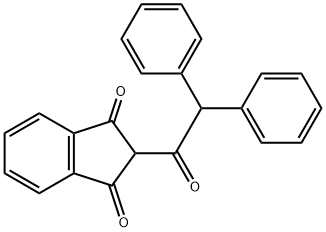다이파시논(디파시논) C화학적 특성, 용도, 생산
개요
Diphacinone is also called 2-(diphenylacetyl)indan-1,3-dione,
is a yellow powder
which is practically insoluble in water, readily soluble
in chloroform, toluene, xylene, acetone, ethanol, heptane,
alkalis [9, p. 431].
용도
Diphacinone is an anticoagulant rodenticide widely used to control rodent infestations.
생산 방법
Diphacinone is produced by condensation of 1,1-diphenyl
acetone with dimethyl phthalate in the presence of sodium
methoxide (30).
일반 설명
Odorless pale yellow crystals. Used as a rodenticide and anticoagulant medication.
공기와 물의 반응
Practically insoluble in water (17mg/L). Hydrolyzed by strong acid.
반응 프로필
DIPHACINONE is a ketone, and behaves as a weak acid. Forms water soluble alkali metal salts. Ketones are reactive with many acids and bases liberating heat and flammable gases (e.g., H2). The amount of heat may be sufficient to start a fire in the unreacted portion of the ketone. Ketones react with reducing agents such as hydrides, alkali metals, and nitrides to produce flammable gas (H2) and heat. Ketones are incompatible with isocyanates, aldehydes, cyanides, peroxides, and anhydrides. They react violently with aldehydes, HNO3, HNO3 + H2O2, and HClO4.
건강위험
DIPHACINONE is extremely toxic; probable oral lethal dose in humans is 5-50 mg/kg, or between 7 drops and 1 teaspoonful for a 150-lb. person. Many medical conditions will be aggravated by DIPHACINONE.
화재위험
When heated to decomposition DIPHACINONE emits acrid smoke and fumes. Sensitive to light.
농업용
Rodenticide: A U.S. EPA restricted Use Pesticide (RUP) when
the formulation contains 3% or more of diphacinone.
Diphacinone is an anti-coagulant rodenticide bait used for
control of rats, mice, voles and other rodents. It is available
in meal, pellet, wax block, and liquid bait formulations, as
well as in tracking powder and concentrate formulations.
It is used in general agriculture and in food-processing areas. The top five uses for diphacinone in California are on
landscapes, general vertebrate pest control, around structures and right of ways, and on oranges. This material is
also used as an anticoagulant medication. Not approved for
use in EU countries.
상품명
DE-PESTER®[C]; DIDANDIN®;
DIPAXIN®; DITRAC®; GOLD CREST®; KILL-RO
RAT KILLER®; LIQUA-TOX®, diphacinone sodium
salt; ORAGULANT®; P. C. Q. ®; PID®; PROMAR®;
RAMIK®; RAT KILLER®; RODENT CAKE®[C];
SOLVAN®; TOMCAT®; U 1363®
Safety Profile
Poison by ingestion.
Inlxbits blood clotting, leading to
hemorrhages. Action similar to coumadin
(warfarin). A pesticide used in rodent
control. When heated to decomposition it
emits acrid smoke and irritating fumes
신진 대사 경로
Diphacinone is a member of the indandione class of anti-coagulants.
Its fate in rats and mice has been reported but no information on its
degradation in soil or plants has been published. It is metabolised by
hydroxylation and conjugation.
다이파시논(디파시논) 준비 용품 및 원자재
원자재
준비 용품








